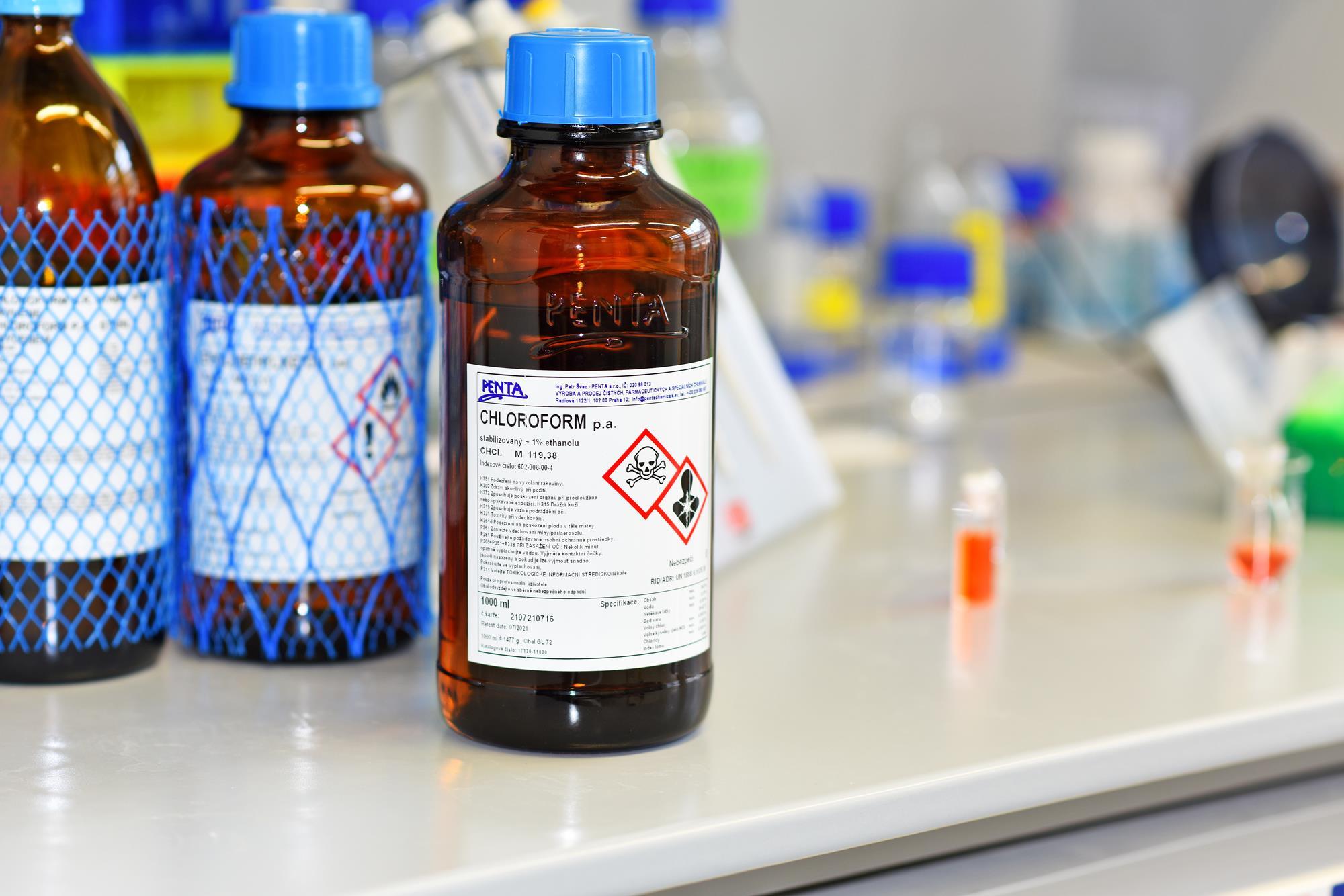Chloroform is a by-product formed when chlorine disinfects water but also has many industrial uses (Delaware). French chemist, Jean-Baptiste Dumas, formally named and characterized chloroform in 1834. Since then, the chemical has been used for a variety of applications, including:
• Solvent in the laboratory and pharmaceutical industries
• Production of dyes
• Bonding agent
• Reagent in organic synthesis
• Anesthetic
• Refrigerant
• Production of tetrafluoroethylene (TFE) which is used to make polytetrafluoroethylene (PTFE) – a primary component in Teflon®
Hazards of Chloroform (CHCl3 ) Vapor
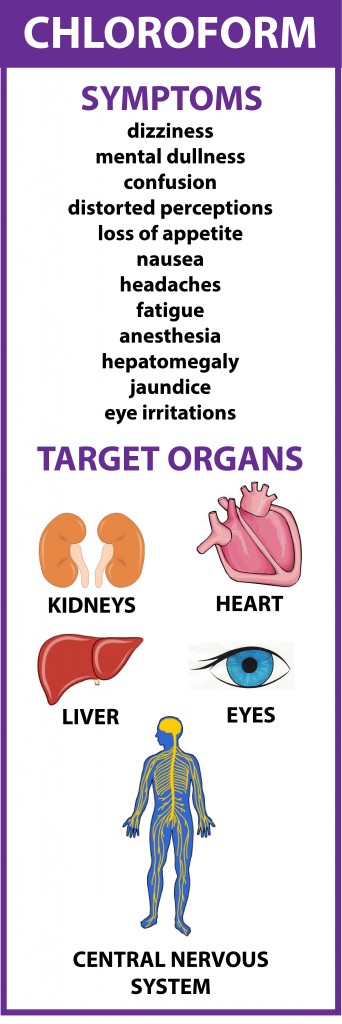 Chloroform exposure mainly occurs through inhalation. Due to its sweet, nonirritating odor, some users may not realize that respiratory safety controls are necessary for user protection. After inhalation possible side effects include headache, fatigue and dizziness. Breathing air with chloroform for a long period damages the brain, liver and kidneys. It may cause cancer.
Chloroform exposure mainly occurs through inhalation. Due to its sweet, nonirritating odor, some users may not realize that respiratory safety controls are necessary for user protection. After inhalation possible side effects include headache, fatigue and dizziness. Breathing air with chloroform for a long period damages the brain, liver and kidneys. It may cause cancer.
Health Side Effects
• Dizziness
• Mental Dullness
• Confusion
• Distorted Perceptions
• Loss of Appetite
• Nausea
• Headaches
• Fatigue
• Anesthesia
• Hepatomegaly
• Jaundice
• Eye Irritations
Target Organs
• Kidneys
• Heart
• Liver
• Eyes
• Central Nervous System
Carcinogenic Classification
Environmental Protection Agency (EPA): 2B – Probable human carcinogen
National Toxicology Program (NTP): 2 – Reasonably anticipated to be a human carcinogen
International Agency for Research on Cancer (IARC): 2B – Probable human carcinogen
Occupational Exposure Regulations
As you can see in the below chart, many agencies recommend varying levels of exposure limits. The limits are primarily based on duration of exposure.
Exposure Guidelines for Chloroform (Trichloromethane // CAS: 67-66-3)
| Agency | Type of Limit | Limit Amount |
| Occupational Safety and Health Administration (OSHA) | Permissible Exposure Limit (PEL) | 50 ppm 240 mg/m3 Ceiling (TWA) |
| American Conference of Governmental Industrial Hygienists (ACGIH) | Threshold Limit Value (TLV) | 10 ppm 49 mg/m3 TWA |
| National Institute for Occupational Safety and Health (NIOSH) | Recommended Exposure Limit (REL) | 2 ppm 9.78 mg/m3 STEL (60 minutes) |
| Immediately Dangerous to Life or Health (IDLH) | 500 ppm |
• TWA – Time weighted average exposure over an 8-hour time period
• TLV – Level to which it is believed a worker can be exposed day after day for a working lifetime without adverse health effects.
• STEL – The acceptable average exposure over a short period of time, as long as the TWA is not exceeded.
• PPM – Parts per million (i.e. 50 parts of chloroform per million parts of air)
Odor Threshold
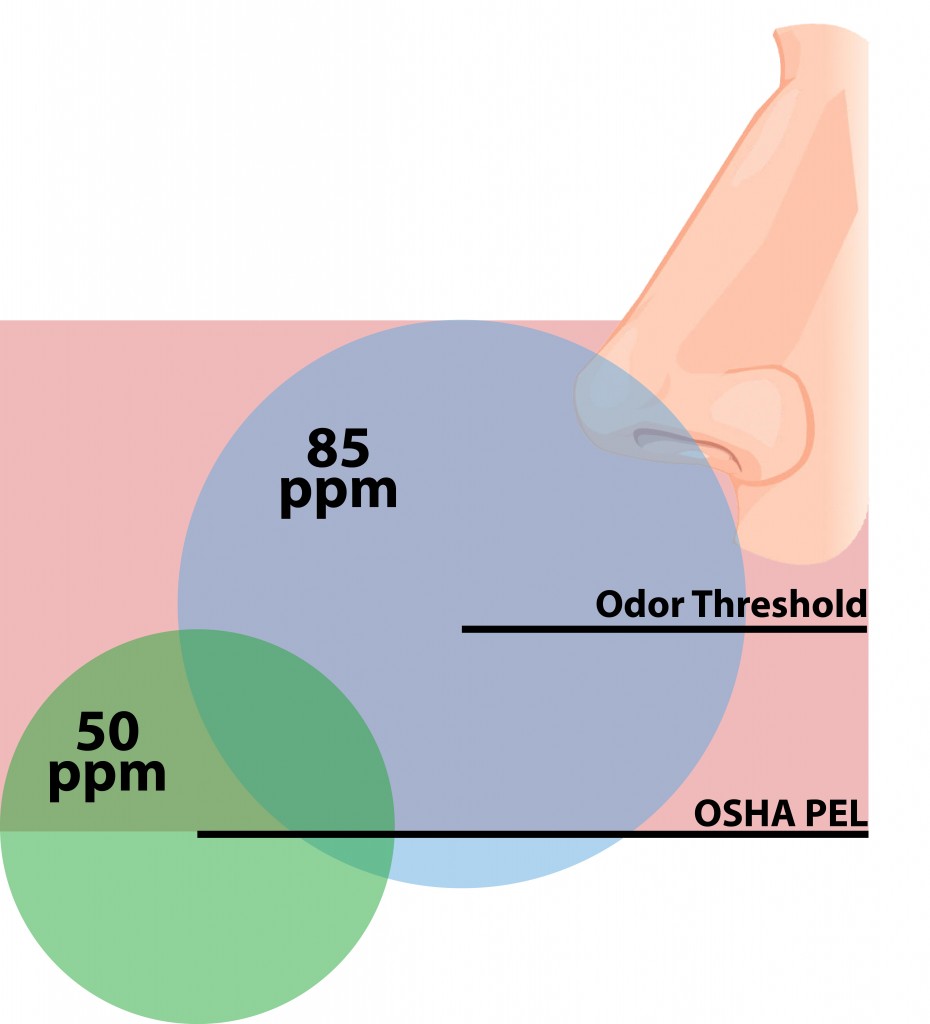 It is important to note that the odor threshold of chloroform is approximately 85 ppm; that is 1.7 times greater than the established PEL of 50 ppm. An odor threshold is the lowest concentration of a certain odor compound that is perceivable by the human sense of smell.
It is important to note that the odor threshold of chloroform is approximately 85 ppm; that is 1.7 times greater than the established PEL of 50 ppm. An odor threshold is the lowest concentration of a certain odor compound that is perceivable by the human sense of smell.
This means that if you are able to smell chloroform in the room air, you have surpassed the exposure limit guideline.
Chloroform Fume Adsorption with Activated Carbon Filtration
A source capture chemical fume extractor equipped with activated granule carbon filtration, is an excellent solution for chloroform vapor control.
 Granule carbon has an intricate porous structure that adsorbs hazardous chloroform molecules before they become airborne and potentially inhaled.
Granule carbon has an intricate porous structure that adsorbs hazardous chloroform molecules before they become airborne and potentially inhaled.
The Agency for Toxic Substances and Disease Registry (ATSDR) developed a ToxFAQs sheet on chloroform, where it states that most of the chloroform in air eventually breaks down, but it is a slow process. This breakdown produces phosgene and hydrogen chloride, which are both toxic (ATSDR).
To ensure chloroform vapors have plenty of time to breakdown and adsorb, a larger carbon filter is recommended.
By increasing filter depth, more carbon granules are added whereby increasing the amount of surface area available for vapor capture and adsorption.
Fume Extraction Systems for Chloroform Fume Control
Sentry Air Systems offers a complete line of chemical fume extractors that come in a variety of sizes and configurations. Equipped with a carbon pre-filter and activated granule carbon main filter, these systems help protect the operator from the inhalation hazards of chloroform. Our Model 300 Series carbon filter media is appropriately sized to allow ample time for chloroform molecules to “bounce around” and adsorb into the granules; resulting in only highly cleansed air being recirculated back into the room.
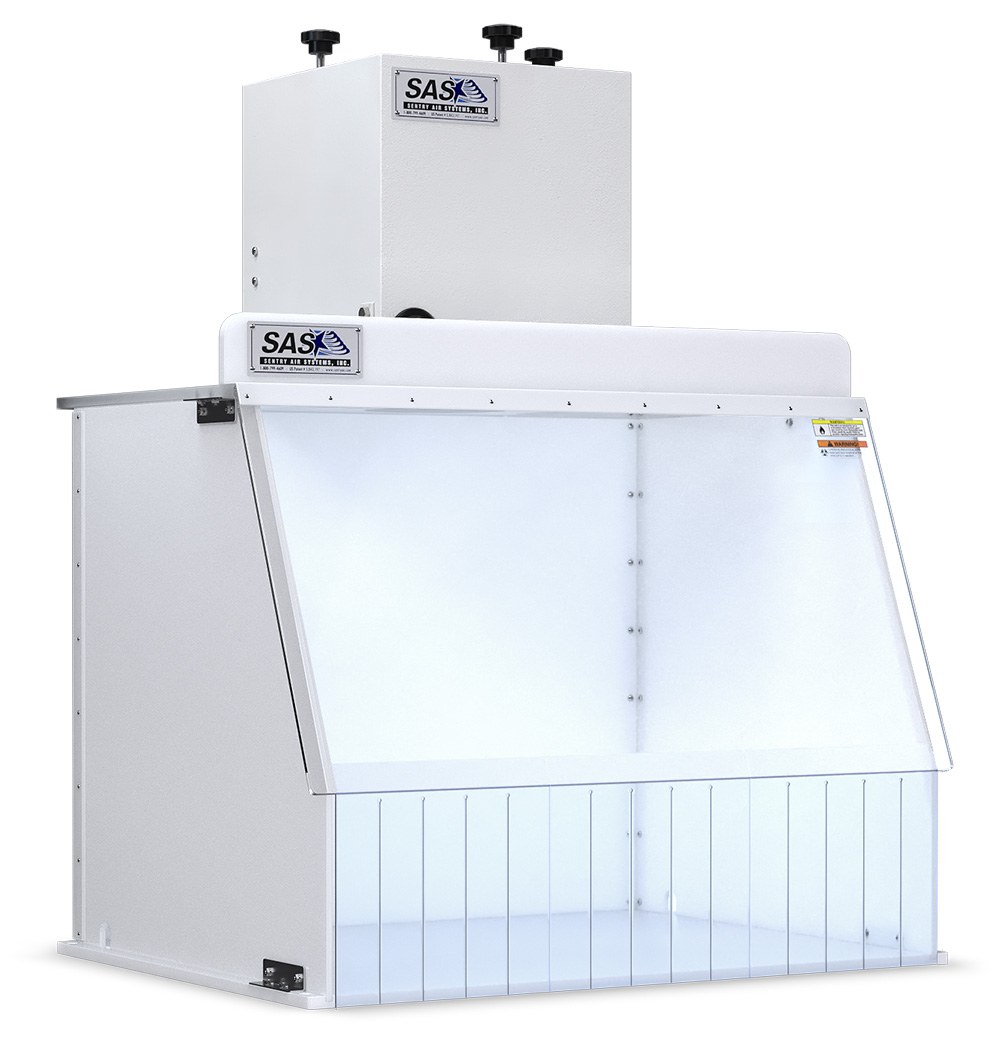
Ductless Fume Hoods help protect the operator by containing fumes and directing them into the filtration system.
Ductless Fume Hoods
Ductless Fume Hoods use a powerful airflow and high-quality filtration to help protect the operator from exposure to harmful fumes and particulate. This system directs fumes away from the operator’s breathing zone into the filtration system and releases the filtered air back into the room. No external ductwork or makeup air required. This sturdy and compact enclosure provides optimal respiratory and environmental protection for a wide variety of applications.
• Standard widths: 24”, 30”, 40”, 50”, 60”, 70”
• Carbon Pre-Filter and Activated Carbon Main Filter
• Compact, Portable, Zero Ductwork Required
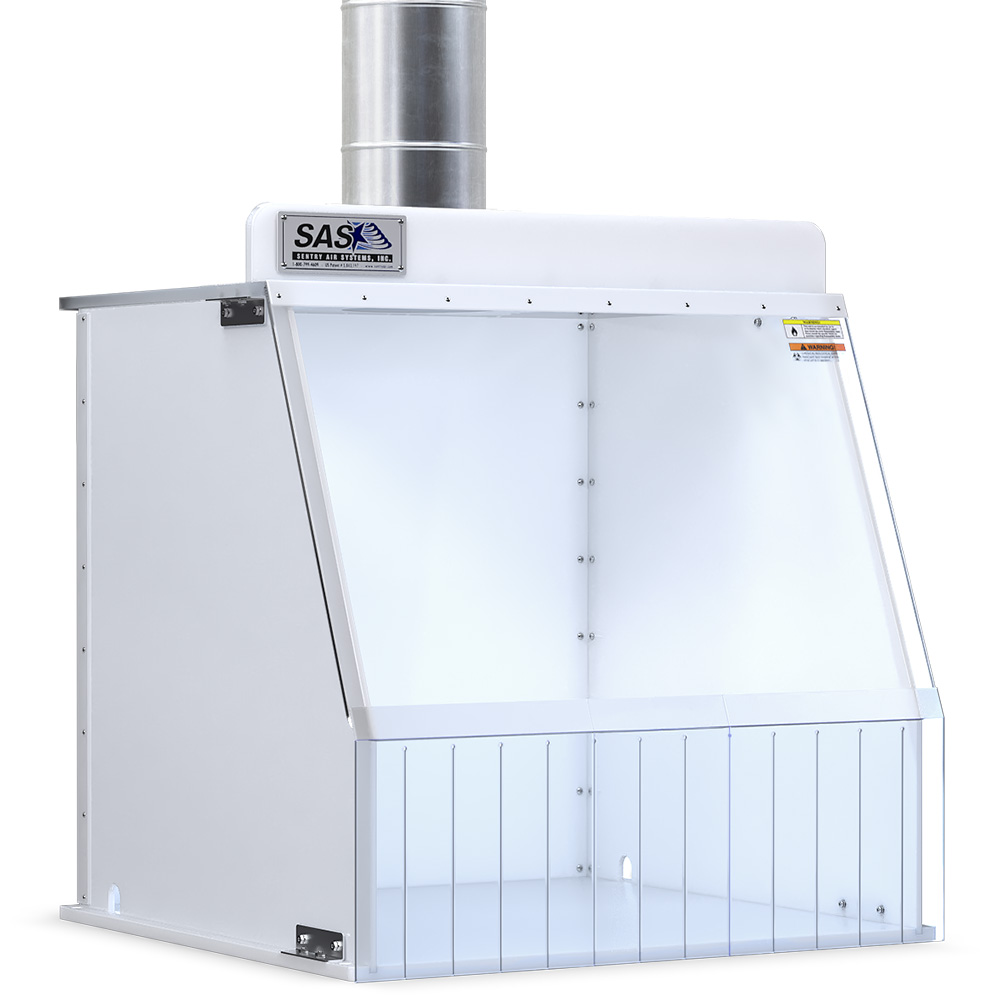
Ducted Fume Hoods use a powerful fan to direct fumes and particulate into the ductwork to be released externaly.
Ducted Fume Hoods
Ducted Fume Hoods provide an external ducting solution for chemical laboratories and applications that use large amounts of volatile chemicals. This exhaust fume hood uses a powerful fan (not included) to draw fumes through the ductwork (not included) to release outside of the building. This system can be used for applications such as evaporating large amounts of volatile organics, working with chemicals that are hard to filter or have a low odor threshold, and heavy powder filling. This hood is constructed of all chemical resistant materials and an exhaust collar. This compact and versatile exhaust hood offers an economical solution for applications that require external ducting.
• Standard widths: 24”, 30”, 40”, 50”, 60”, 70”
• Hood ducts into existing exhaust system
• Compact size
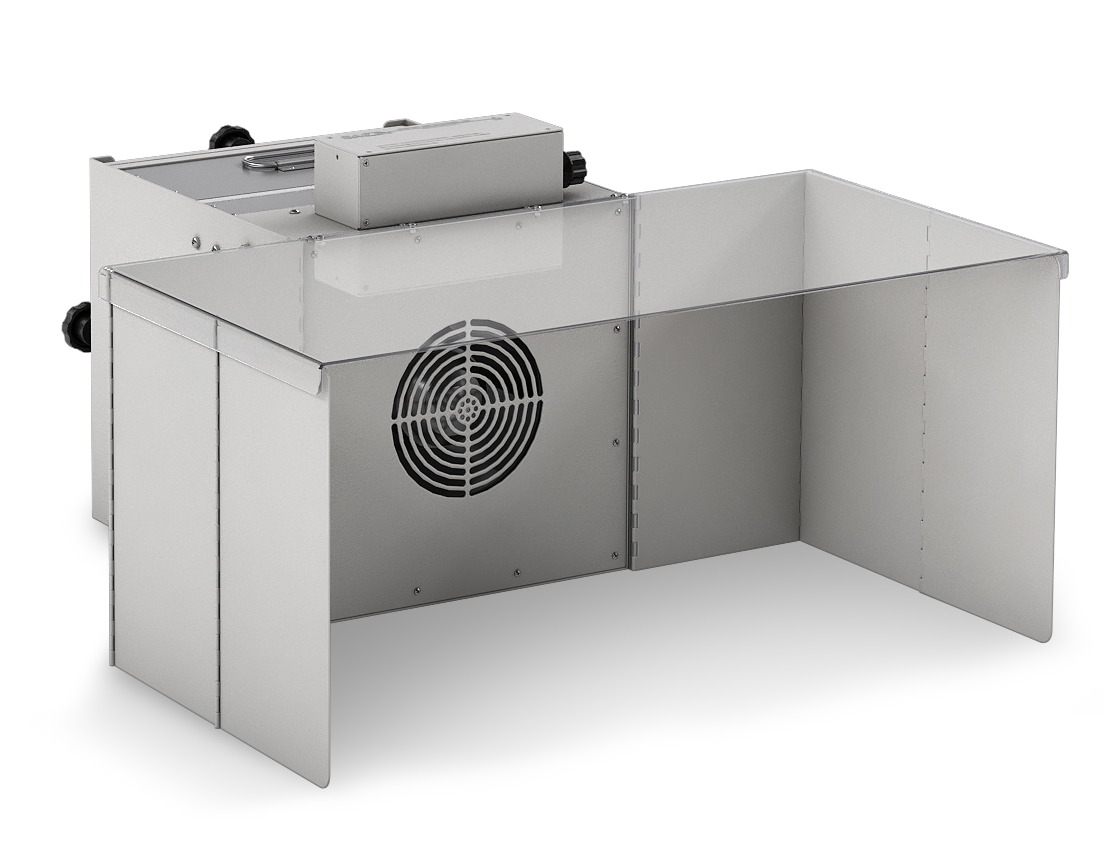
The Model 300 Winged Sentry provides a benchtop fume control solution.
Model 300 Winged Sentry
The Model 300 Winged Sentry with Lid provides a benchtop fume control solution for a variety of applications involving chemical fumes and dusts. The adjustable wing flaps allow the operator to easily move them to suit their application. When used with the acrylic lid, the Winged Sentry creates a hood-like enclosure protecting the operator from fumes and particulate. The wing flaps, lid, and powerful fan work together to direct fumes into the filtration system away from the operator’s breathing zone. After filtration, the system releases the air back into the surrounding room creating a recirculating air flow pattern.
• Adjustable side flaps
• Carbon Pre-Filter and Activated Carbon Main Filter
• Compact, portable, tabletop
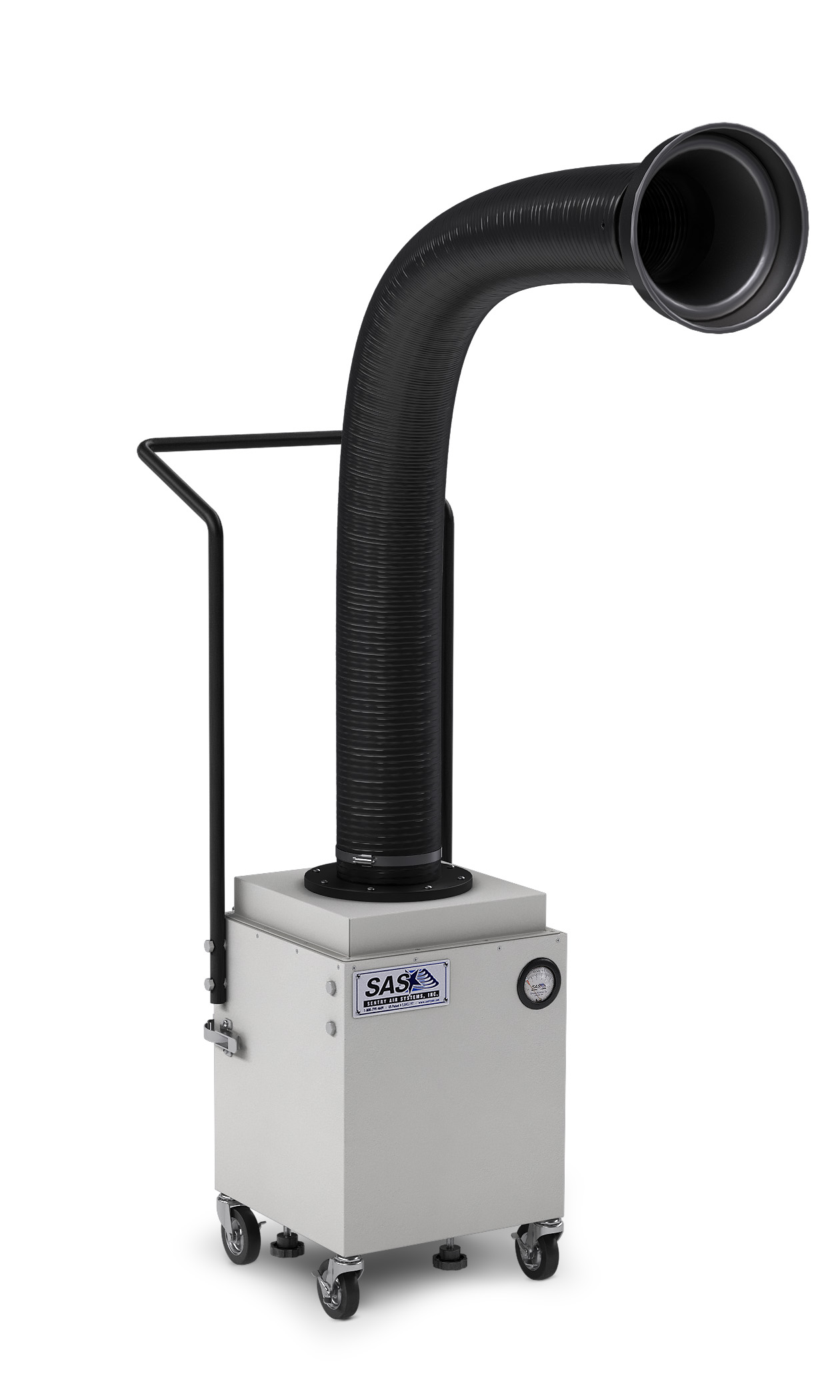
The Model 300 Portable Floor Sentry extracts fumes at the source with a self-supportive capture arm.
Model 300 Portable Fume Extractor
The Model 300 Portable Fume Extractor provides a vital engineering control for medical, laboratory, and industrial facilities. The 68” long capture arm can easily be moved to capture chemical fumes, vapors, and particulate at the source. This model includes a portability handle, heavy-duty casters, a variable speed control, and an easy to change filter system. Both activated carbon and particulate filters can be housed in the filtration chamber to capture both fumes and particulate.
• Locking casters and portability handle
• Semi-self-supportive, flame-resistant black flex hose
• Pulls up to 350 CFM on High
• Carbon Pre-Filter and Activated Carbon Main Filter
Contact Sentry Air
If you work with chloroform, or other chemicals, and seek an air filtration system, contact Sentry Air Systems using the buttons below.



Call us today at 1.800.799.4609
References
Delaware Health and Social Services. Chloroform: Frequently Asked Questions. 2013 Sept. https://www.dhss.delaware.gov/dhss/dph/files/chloroformfaq.pdf
Agency for Toxic Substances and Disease Registry (ATSDR): https://www.atsdr.cdc.gov/toxfaqs/tfacts6.pdf
Environmental Protection Agency (EPA): http://www.epa.gov/ttn/atw/hlthef/chlorofo.html
Occupational Safety and Health Administration (OSHA): https://www.osha.gov/chemicaldata/477
Related Blogs
• Laboratory Fume Hoods
• Rotary Evaporator Fume Control
• Using Filtration to Help Address Common Exhaust Hood Issues – Exhaust Filter Box
• Hydrochloric acid health risks: vapor, mist, and fume inhalation

 Made in the USA
Made in the USA
